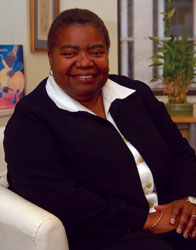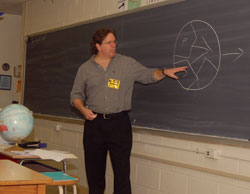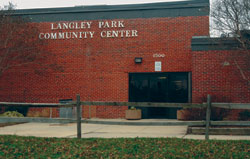Eradicating Violence
Researchers reach deep into the community to help build
safer neighborhoods and schools.
By Jamie L. Freedman
The headlines say it all. Teenagers from rival gangs stab
each other in suburban shopping malls and at high school football
games. Students settle disagreements with guns and violence.
Backpacks now travel through X-ray machines and students through
metal detectors on their way to school. Where will it end?
GW professors are striving to find answers through a number
of promising research projects. A shining example is The George
Washington University’s Hamilton Fish Institute on School
and Community Violence, a national resource for the research
and development of school violence prevention strategies.
Housed in GW’s Graduate School of Education and Human
Development, the interdisciplinary research consortium was
created in 1997 in honor of the late Hamilton Fish IV, a longtime
member of the U.S. House of Representatives from New York
state who advocated joint research to eradicate school violence.
“Juvenile justice and the well-being of young people
were issues close to his heart,” says Beverly Caffee
Glenn, who has directed the institute since 2002. The institute
works with a research consortium of eight universities to
develop and test violence prevention strategies in urban,
rural, and suburban schools across the country. Members include
Eastern Kentucky University, Florida State University, Morehouse
School of Medicine, University of Oregon, Shenandoah University,
Syracuse University, the Trauma Center-Boston, and the University
of Wisconsin-Milwaukee. “We were established to research,
develop, and evaluate programs and practices that help to
prevent youth violence,” Glenn says. Funded by the Department
of Justice’s Office of Juvenile Justice Delinquency
Prevention, the consortium convenes meetings of researchers,
issues small grants, fields investigational studies, and coordinates
an annual national conference.
“Here at Hamilton Fish, we strive to transfer research
into practice,” Glenn says, noting that the institute
works closely with D.C. Public Schools. “This summer,
we held a young people’s summit of local high school
students at the Marvin Center to discuss what the main problems
are and what adults can do to help,” she says. “Over
pizza, one student shared that his high school was built for
1,800 students but houses 2,700, and that not enough adults
in the building care about the students or make them feel
safe. It was an insightful meeting.”

Beverly Caffee Glenn is the director of GW’s Hamilton
Fish Institute on School and Community Violence, established
to research, develop, and evaluate programs and practices
that prevent youth violence.
Jessica McConnell
|

|
The institute conducted a four-day conference in Philadelphia
last year, where some of the nation’s foremost experts
on school violence gathered to discuss the most recent means
and methods for curbing school violence and implementing innovative
programs of prevention. Hamilton Fish hosted this year’s
national conference, “Persistently Safe Schools 2006:
Collaborating with Students, Families & Communities,”
which took place Sept. 19-21 in Washington. “Our annual
meeting routinely draws 250 to 400 participants per year,”
Glenn says. “This year, we focused on persistently safe
schools, because in some cities around the country, there
are no safe schools to transfer into. We provide a forum for
informative discussions about the state of school violence
prevention research, while encouraging partnerships among
public, private, and not-for-profit enterprises.”
GW, which serves as the national office of the institute,
is working on many levels to make the D.C. Public Schools
safe. “Right now, we’re working with a school
in Southeast Washington where a student was recently shot
in the back and killed,” Glenn says. While there’s
no ironclad recipe for success, she says that a number of
strategies do help prevent violence. “It’s important
that schools implement clear, concise, fair rules that apply
to everybody and are fairly applied,” she says. Strong
anti-bullying policies are vital. “We know bullying
leads to violence,” Glenn states, noting that most school
violence occurs between April and June because students have
been bullied since September and are eager to get back at
their aggressors.
“Our research has found that investing in after-school
programs in the humanities, arts, music, drama, and other
emotional outlets for young people plays an important role,
as does mentoring and engaging in rigorous academic pursuits,
regardless of ability,” she continues. “We also
know that safe schools enroll 500 students or less, since
teachers in small schools know all of the kids by name. Large
schools can easily be split into houses, schools within schools,
grade-level academies, special programs, and teams of 500
students or less. It’s not an impossibility. It can
be done.”
Glenn notes that violence decreases when young people are
emotionally and intellectually attached to the adults who
run the schools, as well as when adults are around at home
for kids to talk to. “Kids who are on their own for
hours each day after school are the most likely to get into
trouble,” she says. “When kids have activities
to engage in and positive role models to interact with, they
develop pro-social, rather than anti-social, skills.”
An advocate of universal preschool, Glenn emphasizes that
investment in young people pays off. “Every dollar invested
in preschool generates $7 in terms of social benefits,”
she says.
Glenn cautions that the problem of youth violence cannot
be solved with the wave of a magic wand. “We know young
people’s judgment is not clear until the ages of 23
to 25,” she explains. “Some 420 juveniles in the
District are repeat offenders, and many of them have been
sent away 12 times. It’s just a revolving door, because
these young people have not yet physically developed the ability
to step back and analyze a situation.”
As the institute heads into its 10th year, Glenn is quick
to state that school violence is not as rampant as headlines
might suggest. “The Centers for Disease Control says
that less than 1 percent of violence committed against young
people occurs in school, so despite recent headlines, school
is still the safest place to be,” she concludes.

|

As part of the primary intervention program SAFER Latinos,
Mark Edberg trains high school seniors to become members
of a peer advocate system in local schools.
Jessica McConnell
|
Just a block down K Street, Mark Edberg, associate professor
of prevention and community health, quickly is gaining a national
reputation for his research focusing on ways to reduce Latino
youth violence in the local community. Funded by a four-year,
$2.4 million research grant from the Centers for Disease Control
and Prevention, he is spearheading a study to develop and
test a community-based youth violence prevention program in
Langley Park, Md., a Washington suburb with a substantial
Central American population. “Youth and gang violence
has increased substantially over the past decade in Langley
Park and other similar communities around the country,”
says Edberg, who has spent his career researching violence,
HIV, substance abuse, and other high-risk issues.
Together with two community partners—the Council of
Latino Agencies and the Latin American Youth Center, Edberg,
assisted by Elizabeth Collins, MPH ’04, is implementing
a multipronged intervention called SAFER Latinos, a primary
prevention program addressing community-level mediating factors
that contribute to Latino youth violence.
“Langley Park is impacted by a number of social and
demographic factors, including a lack of resources and an
influx of refugees/immigrants from Central America,”
Edberg says. He points to a number of “funnels”
that contribute to youth alienation and violence in Langley
Park: a pattern of “sequential family immigration”
that erodes family cohesion and leads to a reliance on peer
socialization; a language barrier and paucity of culturally
appropriate services for immigrant youth, resulting in poor
school performance; low awareness/perception of community
support; the presence of several major Latino gangs, including
the infamous MS-13; and the integration of violence into prevalent
youth norms related to status and reputation.
“Informal local data puts the dropout rate for ninth-grade
Latino boys in Langley Park at 50 percent or more,”
Edberg says. “And the percentage of Latino elementary
school students receiving satisfactory ratings on state performance
measures in reading, writing, and math is very low (sometimes
well below 10 percent in specific areas), with males scoring
lower than females, particularly in writing. Because their
school success rate is so low, violence very likely plays
a heightened role in Latinos gaining status and recognition.
Gangs become a social structure through which young people
find a sense of belonging. They have your back all the time
and become like family. Violence simply becomes a piece of
what they have to do to belong and be known.”

A series of events will be held in Langley Park, Md.,
to show Latino youth that there are better ways to gain
respect than through violence.
Jessica McConnell
|

|
Edberg’s study, titled “Primary Prevention Addressing
Community Factors for Latino Youth Violence,” will utilize
a number of techniques aimed at reducing violence in Langley
Park by addressing those factors that contribute to it at
the community level. Trained Latin American social/health
promoters will work with local families, serving as a bridge
to facilitate communication between parents and children,
as well as between school and parents. To address school issues,
a peer advocate system will be put into place, in which successful
high school seniors or college students will serve as mediators
at the local middle school and high school, intervening when
Latino youth are in trouble or considering dropping out and
conducting early conflict resolution. A drop-in center will
be established in the community, offering free academic support,
recreation, counseling, job training, and other youth services.
Ongoing community events will be held and public information
disseminated, including violence prevention messages and events
designed to increase community contact with support services.
The Council of Latino Agencies, a regional umbrella organization,
will run a series of events aimed at involving community youth
in street theater, musical performances, and other activities
that provide emotional outlets and show participants that
there are better ways to make a name for themselves than through
violence.
“At each of these events, as well as at large community-wide
events such as Langley Park Day, we plan to invite social
services to set up tables, staffed by Spanish speakers, to
make linkages to services and address questions of community
alienation,” Edberg says. “In combination with
that, we’ll be running a media campaign featuring messages
on alternatives to violence.
“This is, above all, a community project,” continues
Edberg, who came to GW in 2002 and has a joint appointment
in anthropology and in public health. “It’s our
hope that this type of community-public health approach to
dealing with violence will help to reduce youth involvement
in gangs and violence and ultimately serve as a model for
other communities that might be facing the same situation.”
Currently, Edberg and his team are collecting baseline community
data through door-to-door surveys of a random sample of Langley
Park Latino residents and simultaneously from a similar sample
in the study’s control community in Virginia that will
not receive the intervention. “We’re interviewing
them on topics like family cohesion, self-reported participation
in violence, attitudes to violence, substance abuse, perceived
level of community support, and attitudes to school and school
dropout, and we will assess this information against school
and police data on youth violence,” Edberg says. “We
are also conducting focus groups to assess community perceptions
of the problem.” Once the interventions are in place,
he will monitor results through follow-up surveys, focus groups,
police reports, and other data and keep careful documentation
so others can replicate the project.
“There are not a lot of programs out there to address
the broad interplay of community factors that contribute to
youth violence, so I’m pleased and thankful the CDC
decided to fund this project,” says Edberg, noting the
group funded only three similar projects nationwide. “I
hope that this collaborative effort between GW and the community
stays in place for a long time.”
Across campus in the psychology building, Sharon Lambert,
assistant professor of psychology, is hard at work researching
a related topic—how neighborhood crime, violence, and
poverty affect children and families. Funded by GW’s
Institute for Public Policy, much of Lambert’s work
focuses on the effects of exposure to community violence on
urban children and adolescents, as well as the risk factors
for community violence exposure. “We’re trying
to understand what places kids at a greater risk of being
exposed to community violence, either as witnesses or victims,”
she explains, noting that it is a significant public health
problem with rampant negative consequences.
According to Lambert, risk factors for violence exposure
include being male, living in a poor, urban area, and associating
with deviant or delinquent peers. “There are also behavioral
risks we can target in interventions,” she states. To
date, Lambert has looked closely at the links between violence
exposure and aggression, depression, and anxiety. “We
know aggressive behavior places youth at risk for exposure
to community violence. Aggressive behavior coupled with depression
increases that risk.”
Next on Lambert’s agenda is utilizing the research
to build school- and community-based behavioral intervention
programs to help protect kids at risk for violence exposure.
“My research is mainly focused in Baltimore and Washington,
D.C., which both have high rates of violence, crime, and drug
activity in poor neighborhoods,” she says. “The
big challenge is that, in many poor, low-resource environments
with high crime, kids are praised for being aggressive, and
violence is the norm. It’s hard to combat that.”
A clinical community psychologist, Lambert came to GW two
years ago from the Johns Hopkins University Bloomberg School
of Public Health. “I got into this field because I’m
interested in understanding how neighborhoods affect children
and families,” she explains. “Some families fare
well despite challenging situations, while others experience
more difficulties. I’d like to find out what makes people
resilient to environmental stress, and package those strategies
into interventions for youth.”
Lambert says that she hopes to tie together community and
clinical interventions, such as offering more after-school
activities in poor neighborhoods, to keep kids off the streets.
“One of our goals is to increase access to services
in the communities that need it most,” she says. “I’m
also interested in mapping locations of community risks and
resources to better understand risk for exposure to community
violence, as well as access and utilization of services.”
She’s quick to state that the research is still in
its early days. “The integration of geography and psychology
to understand risk and inform intervention is a fairly new
field,” she says, “but we’re getting there.
By understanding how kids manage neighborhood-related stressors,
such as crime, poverty, and access to fewer resources, we
can help cut down on community violence exposure and its effects,
hopefully soon.”
|